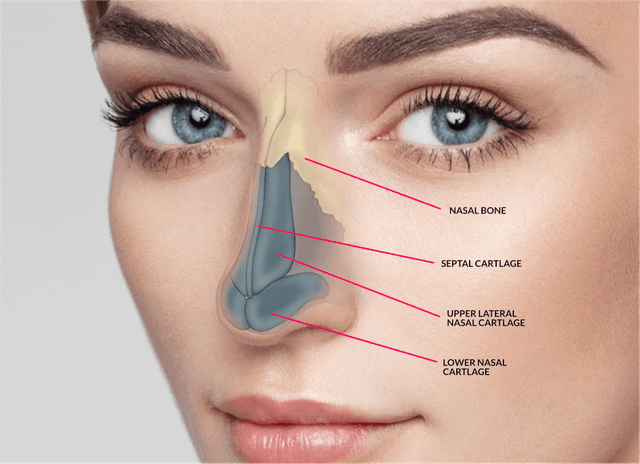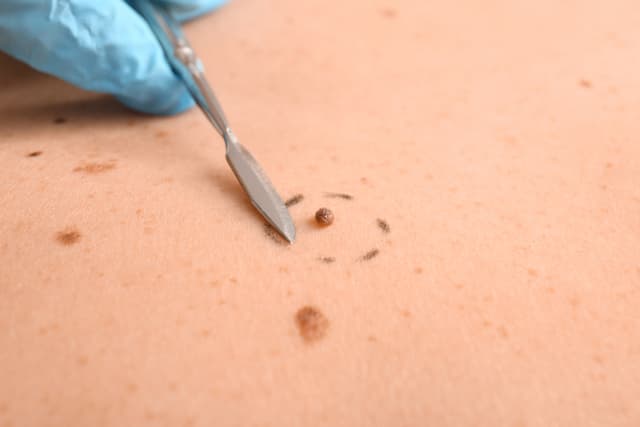Moles are quite common, and most are medically harmless. Still, many people choose to have them removed for cosmetic reasons or on their doctor’s recommendation if you may have cancer risks.
If you’re considering a mole removal procedure or have recently had a mole removed, you’re probably wondering how long it will take for the affected area to heal. Here, we’ll explore the factors that affect healing and provide a general timeline for recovery.
How Moles are Removed
Doctors use a variety of methods to remove moles. Certain techniques are best suited to having non-cancerous, while more complex methods are required when skin cancer is present or suspected.
After administering local anesthetic, your doctor will use one of the following mole removal methods:
- Freezing by using a small amount of liquid nitrogen. This method is used for noncancerous moles.
- Burning with an electric current to remove the upper layers of the mole. This is also reserved for noncancerous mole tissue, as removing just the upper layers may leave cancer cells below the surface.
- Shaving, sometimes called a shave excision, uses a small razor-like tool to carefully slice the mole off the skin’s surface. Again, this is used for moles that are not cancerous.
- Surgical excision, which goes deeper into the skin to cut out the entire mole. This method is used for cancerous moles and ensures that all cancer cells are removed.
How Long it Takes Mole Removal Wounds to Heal
Your wound should be completely healed around one month after surgery. Your scar may be more pronounced early on but will become less noticeable until you reach the one-year mark. At this point, your scar will be fully formed.
With that in mind, what does healing look like after mole removal surgery? It’s usually simple. You will go through three phases of healing:
- Inflammatory Stage – This phase begins around 12 hours after the procedure and wills last around 5 days. You can expect swelling and redness around the wound area, which should subside by the 5-day mark. Ice packs applied to the wound in 20-minute intervals a few times a day can help keep swelling to a minimum. You may also have some light bleeding for the first few hours. This is normal and is not cause for concern.
- Proliferation Stage – This stage begins within 24 hours of the removal and lasts for around one week. It overlaps with the inflammatory stage, and there should be little to no swelling. In the inflammatory phase, your skin will build new healing tissue. A scab may form during this time. It’s important not to pick at the scab, as that can make scarring worse.
- Maturation Stage – The final healing phase can last for up to a year after the surgery. During this phase, your skin will generate new collagen to heal the wound completely. This is when a scar will form and by the one-year mark, your scar should be fully developed.
If your doctor used traditional stitches, they’ll need to be removed 1-2 weeks after your procedure. Many doctors use dissolvable stitches or skin glue, however, which do not require any follow-up.
Preparing for Your Mole Removal Procedure
Mole removal is a relatively simple procedure and does not require extensive preparation. Your doctor, such as The Mole Doctor TM or The Beauty Mark Doctor TM, will provide pre-op instructions, including any that are specific to your case. We recommend wearing loose-fitting clothing, especially if the mole is on your torso or back. This will ensure your clothes fit comfortably over any bandages and do not irritate the wound.
Mole removal is an outpatient procedure, and you should be able to drive yourself home afterward.
Factors That Impact Healing Time
While most wounds will heal in approximately one month, there are several factors that impact the amount of time it takes you to heal:
- Size and Depth of the Mole. Larger and deeper moles require more a more extensive removal procedure, which naturally takes longer to heal. The mole size can dictate the removal method, which also impacts the time it will take to heal.
- Mole Location. Moles in areas that get more blood flow, like the face, can heal faster than those in areas with less blood circulation, like the arms and legs.
- Your Skin Type. Believe it or not, different skin types have varied healing abilities. Healthy, well-hydrated skin tends to heal faster than dry skin.
- Aftercare and Personal Habits. Being diligent with wound care and hygiene practices can quicken the healing process.
How Can I Speed Up Healing After Mole Removal?
While your skin needs time to heal, there are several things you can do to make sure the healing process goes smoothly. Here are our top tips to promote healing and minimize scarring:
- Be sure to keep the wound clean by changing the bandage once or twice a day.
- Avoid using rubbing alcohol to clean the wound. It is extremely drying to the skin and can lengthen healing time.
- Keep the wound moist with over-the-counter ointments like petroleum jelly.
- Protect the wound from water while showering or sweating. Do not swim while the wound is healing.
Above all, follow the wound care instructions provided by your doctor. If you have any questions about scarring or the healing process, don’t hesitate to ask.
Will I Have a Mole Removal Scar?
Scarring is a concern with mole removal, especially if the mole is in a prominent spot, such as your face. The good news is that mole removal scars are typically not very noticeable once they are fully healed. It takes scar tissue around one year to fully develop, and by the one-year mark, your mole removal scar will be fully formed. One of the best ways to help make your mole removal scar less noticeable is by keeping the wound out of direct sunlight.
As we mentioned, mole removal scars tend to be discreet, but occasionly, they may be more noticeable. Hypertrophic scars are more common with serious burns, but there is a risk of this type of scar with any wound. The same goes for keloid and raised scars. Noticeable scars can be treated with laser treatments, microneedling, corticosteroid injections, or scar revision surgery to reduce their appearance.
Risks of Mole Removal
Having a mole removed is generally very safe. But as with most medical procedures, minor risks are present.
The most common risk is infection, which is more likely if proper wound care isn’t followed. Keeping the area clean and changing the bandages daily are the best ways to prevent infection.
Scarring is also a risk, but measures can be taken to reduce the amount of scar tissue that develops.
Your doctor will take care to minimize these risks, and it’s up to you to follow the aftercare tips to lessen risks during the healing process.
Mole Removal in Beverly Hills
If you have moles you’d like to have removed, trust Dr. Ardesh. Schedule your consultation online or calling us at (424) 242-8608



